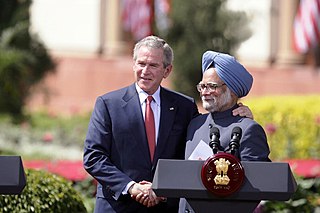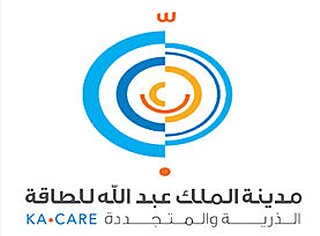Related Research Articles

The Nyongbyon Nuclear Scientific Research Center is North Korea's major nuclear facility, operating its first nuclear reactors. It is located in Nyongbyon County in North Pyongan Province, about 100 km north of Pyongyang. The center produced the fissile material for North Korea's six nuclear weapon tests from 2006 to 2017, and since 2009 is developing indigenous light water reactor nuclear power station technology.
The Jožef Stefan Institute (IJS) is the largest research institute in Slovenia. The main research areas are physics, chemistry, molecular biology, biotechnology, information technologies, reactor physics, energy and environment. At the beginning of 2013 the institute had 962 employees, 404 of them were Ph.D scientists.

SCK CEN, until 2020 shortened as SCK•CEN, is the Belgian nuclear research centre located in Mol, Belgium, more specifically near the township of Donk. SCK CEN is a global leader in the field of nuclear research, services, and education.

The Bhabha Atomic Research Centre (BARC) formerly known as Atomic Energy Establishment, Trombay is India's premier nuclear research facility, headquartered in Trombay, Mumbai, Maharashtra. Founded by Homi Jehangir Bhabha Atomic Energy Establishment, Trombay (AEET) in January 1954 as a multidisciplinary research program essential for the india's nuclear program. It operates under the Department of Atomic Energy(DAE) which is directly overseen by the Prime Minister of India. In 1966 after the death of Homi Jehangir Bhabha AEET renamed as Bhabha Atomic Research Centre (BARC) BARC is a multi-disciplinary research centre with extensive infrastructure for advanced research and development covering the entire spectrum of nuclear science, chemical engineering, material sciences & metallurgy, electronic instrumentation, biology and medicine, supercomputing, high-energy physics and Plasma physics and associated research for Indian nuclear programme and related areas.

North Korea (DPRK) has been active in developing nuclear technology since the 1950s.

The Department of Atomic Energy (DAE) is a department under the Prime Minister of India with headquarters in Mumbai, Maharashtra, India. DAE was established in 1954 by a Presidential Order. DAE has been engaged in the development of nuclear power technology, applications of radiation technologies in the fields of agriculture, medicine, industry and basic research. DAE comprises five research centres, three industrial organisations, five public sector undertakings and three service organisations. It has under its aegis two boards for promoting and funding extramural research in nuclear and allied fields, mathematics and a national institute. It also supports eight institutes of international repute engaged in research in basic sciences, astronomy, astrophysics, cancer research and education. It also has in its fold an educational society that provides educational facilities for children of DAE employees. The important programmes of the DAE are directed towards:

The 123 Agreement signed between the United States of America and the Republic of India is known as the U.S.–India Civil Nuclear Agreement or Indo-US nuclear deal. The framework for this agreement was a July 18, 2005, joint statement by then Indian Prime Minister Dr.Manmohan Singh and then U.S. President George W. Bush, under which India agreed to separate its civil and military nuclear facilities and to place all its civil nuclear facilities under International Atomic Energy Agency (IAEA) safeguards and, in exchange, the United States agreed to work toward full civil nuclear cooperation with India. This U.S.-India deal took more than three years to come to fruition as it had to go through several complex stages, including amendment of U.S. domestic law, especially the Atomic Energy Act of 1954, a civil-military nuclear Separation Plan in India, an India-IAEA safeguards (inspections) agreement and the grant of an exemption for India by the Nuclear Suppliers Group, an export-control cartel that had been formed mainly in response to India's first nuclear test in 1974. In its final shape, the deal places under permanent safeguards those nuclear facilities that India has identified as "civil" and permits broad civil nuclear cooperation, while excluding the transfer of "sensitive" equipment and technologies, including civil enrichment and reprocessing items even under IAEA safeguards. On August 18, 2008 the IAEA Board of Governors approved, and on February 2, 2009, India signed an India-specific safeguards agreement with the IAEA. After India brought this agreement into force, inspections began in a phased manner on the 35 civilian nuclear installations India has identified in its Separation Plan. The deal is seen as a watershed in U.S.-India relations and introduces a new aspect to international nonproliferation efforts. On August 1, 2008, the IAEA approved the safeguards agreement with India, after which the United States approached the Nuclear Suppliers Group (NSG) to grant a waiver to India to commence civilian nuclear trade. The 48-nation NSG granted the waiver to India on September 6, 2008 allowing it to access civilian nuclear technology and fuel from other countries. The implementation of this waiver made India the only known country with nuclear weapons which is not a party to the Non-Proliferation Treaty (NPT) but is still allowed to carry out nuclear commerce with the rest of the world.

Nuclear power is the fifth-largest source of electricity in India after coal, gas, hydroelectricity and wind power. As of November 2020, India has 22 nuclear reactors in operation in 7 nuclear power plants, with a total installed capacity of 6,780 MW. Nuclear power produced a total of 35 TWh and supplied 3.22% of Indian electricity in 2017. 7 more reactors are under construction with a combined generation capacity of 4,300 MW.

Iran's nuclear program is made up of a number of nuclear facilities, including nuclear reactors and various nuclear fuel cycle facilities.

India's three-stage nuclear power programme was formulated by Homi Bhabha in the 1950s to secure the country's long term energy independence, through the use of uranium and thorium reserves found in the monazite sands of coastal regions of South India. The ultimate focus of the programme is on enabling the thorium reserves of India to be utilised in meeting the country's energy requirements. Thorium is particularly attractive for India, as it has only around 1–2% of the global uranium reserves, but one of the largest shares of global thorium reserves at about 25% of the world's known thorium reserves. However, thorium is more difficult to use than uranium as a fuel because it requires breeding, and global uranium prices remain low enough that breeding is not cost effective.

The nuclear power debate is a long-running controversy about the risks and benefits of using nuclear reactors to generate electricity for civilian purposes. The debate about nuclear power peaked during the 1970s and 1980s, as more and more reactors were built and came online, and "reached an intensity unprecedented in the history of technology controversies" in some countries. Thereafter, the nuclear industry created jobs, focused on safety, and public concerns mostly waned. In the last decade, however, with growing public awareness about climate change and the critical role that carbon dioxide and methane emissions plays in causing the heating of the earth's atmosphere, there has been a resurgence in the intensity of the nuclear power debate. Nuclear power advocates and those most concerned about climate change point to nuclear power's reliable, emission-free, high-density energy, alongside a generation of young physicists and engineers working to bring a new generation of nuclear technology into existence to replace fossil fuels. On the other hand, skeptics point to nuclear accidents such as the death of Louis Slotin, the Windscale fire, the Three Mile Island accident, the Chernobyl disaster, and the Fukushima Daiichi nuclear disaster, combined with escalating acts of global terrorism, to argue against continuing use of the technology.

Munir Ahmad Khan, NI, HI, FPAS, was a Pakistani nuclear reactor physicist who is credited, among others, with being the "father of the atomic bomb program" of Pakistan for their leading role in developing their nation's nuclear weapons during the successive years after the war with India in 1971.
Padmanabha Krishnagopala Iyengar, was an Indian nuclear physicist who is widely known for his central role in the development of the nuclear program of India. Iyengar previously served as the director of BARC and former chairman of the Atomic Energy Commission of India, he raised his voice and opposition against the nuclear agreement between India and the United States and expressed that the deal favoured the United States.

Since about 2001 the term nuclear renaissance has been used to refer to a possible nuclear power industry revival, driven by rising fossil fuel prices and new concerns about meeting greenhouse gas emission limits.
Jaitapur Nuclear Power Project is a proposed nuclear power plant in India. If built, it would be the largest nuclear power generating station in the world by net generation capacity, at 9,900 MW. The power project is proposed by Nuclear Power Corporation of India (NPCIL) and would be built at Madban village of Ratnagiri district in Maharashtra.
M. V. Ramana is a physicist who works at the Nuclear Futures Laboratory and the Program on Science and Global Security, both at Princeton University, on the future of nuclear power in the context of climate change and nuclear disarmament. Ramana is a member of the International Panel on Fissile Materials and the Bulletin of the Atomic Scientists’ Science and Security Board.

Ratan Kumar Sinha, is an Indian nuclear scientist and mechanical engineer. He had served as the Secretary to the Government of India, Department of Atomic Energy (DAE) and Chairman of the Atomic Energy Commission (AEC), Government of India from April 2012 to October 2015. Prior to that, Ratan Kumar Sinha had served as Director of Bhabha Atomic Research Centre (BARC), Mumbai from May 2010 to June 2012. During the four decades of his illustrious career, Ratan Kumar Sinha held several important positions related to design & development of nuclear reactors for the Indian nuclear programme. He has been actively involved in the development of Advanced Heavy Water Reactor (AHWR) and Compact High Temperature Reactor (CHTR), two of the highly acknowledged technological innovations which are suitable for large scale deployment of nuclear power, particularly in Indian scenario.

The King Abdullah City for Atomic and Renewable Energy (K.A.CARE) is a scientific, research and governmental entity in the Kingdom of Saudi Arabia that is legally independent chaired by the Minister of Energy, which deals with the issues of nuclear and renewable energy in Saudi Arabia and contributes to the sustainable development of the energy sector in the Kingdom and founded in 2010 headquartered in Riyadh city.
Iqbal Hussain Qureshi 27 September 1937 – 8 December 2012) SI, FPAS, best known as I.H. Qureshi, was a Pakistani nuclear chemist and an Emeritus professor of chemistry at the University of Karachi. Qureshi was the principal contributor of scientific understanding of various chemical elements: bismuth, cobalt, strontium, thallium, tritium, iron, rubidium, and zinc.

Valangiman Subramanian Ramamurthy is an Indian nuclear physicist with a broad range of contributions from basic research to Science and Engineering administration.Prof.Ramamurthy started his career in Bhabha Atomic Research Centre, Mumbai in the year 1963. He made important research contributions in the area of nuclear fission,medium energy heavy ion reactions, statistical and thermodynamic properties of nuclei and low energy accelerator applications. During the period 1995-2006, Prof.Ramamurthy was fully involved in Science administration as Secretary to Government of India, Department of Science and Technology, (DST), New Delhi.Other important assignments held by him include Director, Institute of Physics, Bhubaneswar, (1989-1995), DAE Homi Bhabha Chair in the Inter-University Accelerator Centre, New Delhi (2006-2010), and Director of the National Institute of Advanced Studies, Bengaluru (2009-2014). He is a former chairman of the Recruitment and Assessment Board of the Council of Scientific and Industrial Research and has served as a member of the design team of the first Indian nuclear experiment in Pokhran on 18 May 1974. The Government of India awarded him the third highest Indian civilian honour of Padma Bhushan in 2005.
References
- ↑ "World's first nuclear energy partnership centre in state". The Times of India . GURGAON. 4 December 2010. Archived from the original on 4 November 2012. Retrieved 28 December 2010.
- ↑ "France, Russia to assist India to set up global centre for nuclear energy". PTI. Chandigarh: DNA. 3 December 2010. Retrieved 28 December 2010.
- ↑ "India warns of A.Q. Khan network, unveils global nuclear centre". Sifi news. 13 April 2010. Archived from the original on 17 October 2012. Retrieved 28 December 2010.
- ↑ "India to set up centre for N-energy applications". ET BUREAU. New Delhi: Economic Times. 14 April 2010. Retrieved 28 December 2010.
- ↑ [|http://www.gcnep.gov.in/ About]